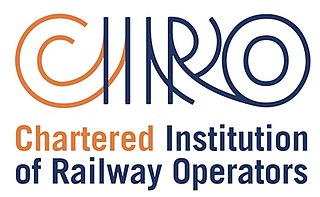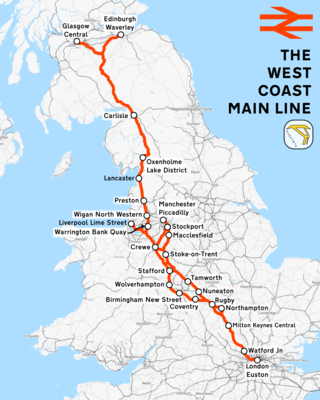
The Post Office Railway, known since 1987 as Mail Rail, is a 2 ft narrow gauge, driverless underground railway in London that was built by the Post Office with assistance from the Underground Electric Railways Company of London, to transport mail between sorting offices. Inspired by the Chicago Tunnel Company, it opened in 1927 and operated for 76 years until it closed in 2003. A museum within the former railway was opened in September 2017.
The Permanent Way Institution is a technical Institution which aims to provide technical knowledge, advice and support to all those engaged in rail infrastructure systems worldwide.

Rail transport is a means of transport using wheeled vehicles running in tracks, which usually consist of two parallel steel rails. Rail transport is one of the two primary means of land transport, next to road transport. It is used for about 8% of passenger and freight transport globally, thanks to its energy efficiency and potentially high speed.

The Waterloo & City line, colloquially known as The Drain, is a London Underground shuttle line that runs between Waterloo and Bank with no intermediate stops. Its primary traffic consists of commuters from south-west London, Surrey and Hampshire arriving at Waterloo main line station and travelling forward to the City of London financial district. For this reason, the line has historically not operated on Sundays or public holidays, except in very limited circumstances. Following the COVID-19 pandemic, the line is currently only open on weekdays. It is one of only two lines on the Underground network to run completely underground, the other being the Victoria line.

Network Rail Limited is the owner and infrastructure manager of most of the railway network in Great Britain. Network Rail is a non-departmental public body of the Department for Transport with no shareholders, which reinvests its income in the railways.

The Great Western Main Line (GWML) is a main line railway in England that runs westwards from London Paddington to Bristol Temple Meads. It connects to other main lines such as those from Reading to Penzance and Swindon to Swansea. The GWML is presently a part of the national rail system managed by Network Rail while the majority of passenger services upon it are provided by the current Great Western Railway franchise.
Established in 1840, His Majesty's Railway Inspectorate (HMRI) is the organisation responsible for overseeing safety on Britain's railways and tramways. It was previously a separate non-departmental public body, but from 1990 to April 2006 it was part of the Health and Safety Executive. It was then transferred to the Office of Rail and Road and ceased to exist by that name in May 2009 when it was renamed the Safety Directorate. However, in summer 2015 its name was re-established as the safety arm of ORR.

The Office of Rail and Road (ORR) is a non-ministerial government department responsible for the economic and safety regulation of Britain's railways, and the economic monitoring of National Highways.
Oswald Stevens Nock, B. Sc., DIC, C. Eng, M.I.C.E., M.I.Mech.E., M.I.Loco.E.,, nicknamed Ossie, was a British railway signal engineer and senior manager at the Westinghouse company; he is well known for his prodigious output of popularist publications on railway subjects, including over 100 books, as well as many more technical works on locomotive performance.

SimSig is a mixed donationware and commercial Windows-based train simulator of modern railway signalling systems in Great Britain, from the point of view of a railway signaller. Users have also had success running SimSig on Linux using Wine.
Railway engineering is a multi-faceted engineering discipline dealing with the design, construction and operation of all types of rail transport systems. It encompasses a wide range of engineering disciplines, including civil engineering, computer engineering, electrical engineering, mechanical engineering, industrial engineering and production engineering. A great many other engineering sub-disciplines are also called upon.
The Indian Railway Service of Signal Engineers (IRSSE) is a central engineering services group A cadre of the Indian railways. The officers of this service are responsible for managing the Signal and Telecommunications Engineering Organization of the Indian Railways.
The Indian Railways Service of Engineers (IRSE) is one of the oldest group 'A' central engineering services recruited through the engineering services examination of the Union Public Service Commission. The officers of this service are responsible for administering the Civil Engineering organisation of the Indian Railways
Colwich Junction is a rail junction near the village of Little Haywood, in the county of Staffordshire, England. It is the junction between two routes of the West Coast Main Line: the Trent Valley line and the Stone to Colwich cutoff line. The junction was the site of the 1986 Colwich rail crash.

The Doha Metro is a rapid transit system in the Doha Metropolitan Area of Qatar's capital city Doha, which became operational on 8 May 2019. It has three lines with an approximate overall length of 76 km (47 mi) and 37 stations. It is an integral component of the larger Qatar Rail network, which will include a long-distance rail for passengers and freight, linking Qatar to the GCC, and the Lusail LRT. Capable of reaching 100 km/h (62 mph), the Doha Metro has one of the fastest driverless trains in the world.

The CharteredInstitution of Railway Operators is the professional body for all those engaged or interested in railway operations and its allied disciplines. It exists for its members and the rail industry as a whole. It was awarded Chartered status on 1 October 2021.

A rail operating centre (ROC) is a building that houses all signallers, signalling equipment, ancillaries and operators for a specific region or route on the United Kingdom's main rail network. The ROC supplants the work of several other signal boxes which have thus become redundant.

Elsie Louisa Winterton, also known as Elsie Louisa Deacon was a draughtswoman for the Great Western Railway (GWR) who became the first woman member of the United Kingdom's Institution of Railway Signal Engineers in 1923.

The West Coast Main Line is a key strategic railway line in the United Kingdom. It links the cities of London, Glasgow, Birmingham, Liverpool, Manchester, Preston, Lancaster and Carlisle. Virgin Trains took on the franchise to run train services on the routes in 1997 and as part of the agreement wanted an upgrade to the railway line to allow for faster more frequent trains to grow the business. The upgrade started in 1998 and was completed in 2009. It came under parliamentary and media scrutiny because of cost and schedule overruns. Further improvements such as the Norton Bridge rail flyover were completed after these dates. The project is sometimes given the acronym WCRM - West Coast Route Modernisation.











